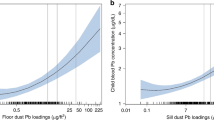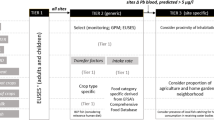Abstract
Superfund sites that are contaminated with lead and undergoing remedial action generate lead-enriched dust that can be released into the air. Activities that can emit lead-enriched dust include demolition of lead smelter buildings, stacks, and baghouses; on-site traffic of heavy construction vehicles; and excavation of soil. Typically, air monitoring stations are placed around the perimeter of a site of an ongoing remediation to monitor air lead concentrations that might result from site emissions. The National Ambient Air Quality (NAAQ) standard, established in 1978 to be a quarterly average of 1.5 μg/m3, is often used as a trigger level for corrective action to reduce emissions. This study explored modeling approaches for assessing potential risks to children from air lead emissions from the RSR Superfund site in West Dallas, TX, during demolition and removal of a smelter facility. The EPA Integrated Exposure Uptake Biokinetic (IEUBK) model and the International Commission of Radiologic Protection (ICRP) lead model were used to simulate blood lead concentrations in children, based on monitored air lead concentrations. Although air lead concentrations at monitoring stations located in the downwind community intermittently exceeded the NAAQ standard, both models indicated that exposures to children in the community areas did not pose a significant long-term or acute risk. Long-term risk was defined as greater than 5% probability of a child having a long-term blood lead concentration that exceeded 10 μg/dl, which is the CDC and the EPA blood lead concern level. Short-term or acute risk was defined as greater than 5% probability of a child having a blood lead concentration on any given day that exceeded 20 μg/dl, which is the CDC trigger level for medical evaluation (this is not intended to imply that 20 μg/dl is a threshold for health effects in children exposed acutely to airborne lead). The estimated potential long-term and short-term exposures at the downwind West Dallas community did not result in more than 5% of children exceeding the target blood lead levels. The models were also used to estimate air lead levels for short-term and long-term exposures that would not exceed specified levels of risk (risk-based concentrations, RBCs). RBCs were derived for various daily exposure durations (3 or 8 h/day) and frequencies (1–7 days/week). RBCs based on the ICRP model ranged from 0.3 (7 days/week, 8 h/day) to 4.4 μg/m3 (1 day/week, 3 h/day) for long-term exposures and were lower than those based on the IEUBK model. For short-term exposures, the RBCs ranged from 3.5 to 29.0 μg/m3. Recontamination of remediated residential yards from deposition of air lead emitted during remedial activities at the RSR Superfund site was also examined. The predicted increase in soil concentration due to lead deposition at the monitoring station, which represented the community at large, was 3.0 mg/kg. This potential increase in soil lead concentration was insignificant, less than 1% increase, when compared to the clean-up level of 500 mg/kg developed for residential yards at the site.
This is a preview of subscription content, access via your institution
Access options
Subscribe to this journal
Receive 6 print issues and online access
$259.00 per year
only $43.17 per issue
Buy this article
- Purchase on Springer Link
- Instant access to full article PDF
Prices may be subject to local taxes which are calculated during checkout



Similar content being viewed by others
Abbreviations
- ATSDR:
-
Agency for Toxic Substances and Disease Registry
- CDC:
-
Centers for Disease Control
- DOE:
-
Department of Energy
- EPA:
-
Environmental Protection Agency
- GM:
-
geometric mean
- GSD:
-
geometric standard deviation
- ICRP:
-
International Commission on Radiologic Protection
- IEUBK:
-
Integrated Exposure Uptake Biokinetic
- NAAQ:
-
National Ambient Air Quality
- NPL:
-
National Priority List
- P 10 :
-
probability of a child having a blood lead concentration of 10 μg/dl
- P 20 :
-
probability of a child having a blood lead concentration of 20 μg/dl
- PM10:
-
particulate matter having an aerodynamic diameter less than or equal to 10 μm
- RI/FS:
-
Remedial Investigation/Feasibility Study
- RBC:
-
Risk-Based Concentration
- TSP:
-
Total Suspended Particulate
References
ATSDR. Toxicological Profile for Lead (Update). U.S. Department of Health and Human Services, Public Health Service, Agency for Toxic Substances and Disease Registry, Atlanta, GA, 1999.
Bert J.L., Van Dusen L.J. and Grace J.R. A generalized model for the prediction of lead body burdens. Environ Res 1989: 48: 117–127.
CDC. Preventing Lead Poisoning in Young Children. Centers for Disease Control and Prevention, Atlanta, GA, October 1991.
Chamberlain A.C., Heard M.J., Little P., Newton D., Wells A.C. and Wiffen R.D. Investigations into Lead from Motor Vehicles. United Kingdom Atomic Energy Authority, Harwell, Oxfordshire, 1978; AERE-R 9198.
ENTACT. Remedial Action Workplan for RSR Corporation Superfund Site. Operable Unit No. 4, Irving, TX, 2000.
Hogan K., Marcus A., Smith R. and White P. Integrated Exposure Uptake Biokinetic Model for Lead in Children: empirical comparisons with epidemiological data. Environ Health Perspect 1998: 106(suppl 6): 1557–1567.
Hursh J.B. and Mercer T.T. Measurement of 212Pb loss rate from human lungs. J Appl Physiol 1970: 28: 268–274.
Hursh J.B., Schraub A., Sattler E.L. and Hofmann H.P. Fate of 212Pb inhaled by human subjects. Health Phys 1969: 16: 257–267.
ICRP. Age-Specific Biokinetics Models for the Alkaline Earth Elements. International Commission on Radiologic Protection, 1993: 95–120 Publication No. 67.
James A.C., Stahlhofen W., Rudolf G., Köbrich R., Briant K.S., Egan M.J., Nixon W. and Birchall A. Deposition of inhaled particles. Ann ICRP 1994: 24(1–3): 231–299.
LaKind J.S. Comparison of three models for pediatric blood lead levels in children: episodic exposures to lead. J Expos Anal Environ Epidemiol 1998: 8(3): 339–406.
Lapple C.E. SRI J 1961: 5: 95.
Leggett R.W. An age-specific kinetic model of lead metabolism in humans. J Environ Health Perspect 1993: 101(7): 598–616.
Leggett R.W., Eckerman K.F. and Williams L.R. An elementary method for implementing complex biokinetic models. Health Phys 1993: 64: 260–271.
Morrow P.E., Beiter H., Amato F. and Gibb F.R. Pulmonary retention of lead: an experimental study in man. Environ Res 1980: 21: 373–384.
O'Flaherty E.J. Physiologically based models for bone-seeking elements: III. Human skeletal and bone growths. Toxicol Appl Pharmacol 1991: 111: 332–341.
O'Flaherty E.J. Physiologically based models for bone-seeking elements: IV. Kinetics of lead disposition in humans. Toxicol Appl Pharmacol 1993: 118: 16–29.
O'Flaherty E.J. Physiologically based models for bone-seeking elements: V. Lead absorption and disposition in childhood. Toxicol Appl Pharmacol 1995: 131: 297–308.
Pounds J.G. and Leggett R.W. The ICRP age-specific biokinetic model for lead: validations, empirical comparisons, and explorations. Environ Health Perspect 1998: 106: 1505–1522.
Smith M.A., Grant L.D. and Sors A.I. Lead Exposure and Child Development: An International Assessment. Kluwer Academic Publishing, Dordrecht, GDR, 1989.
U.S. Environmental Protection Agency. National primary and secondary ambient air quality standards for lead. Fed Regist October 5, 1978: 43(194).
U.S. Environmental Protection Agency. Guidelines for carcinogen risk assessment. Fed Regist 1986: 51: 33992–34012.
U.S. Environmental Protection Agency. Review of the National Ambient Air Quality Standards for Lead: Exposure Analysis Methodology and Validation. Office of Air Quality Planning and Standards, Research Triangle Park, NC, 1989; EPA-450/2-89-011
U.S. Environmental Protection Agency. Supplement to the 1986 EPA Air Quality Criteria Document for Lead: Vol. 1. Addendum. Office of Health and Environmental Assessment, Washington, DC, 1989; EPA/600/8-89/049App. A1–A67.
U.S. Environmental Protection Agency. Revised Interim Soil Lead Guidance for CERCLA Sites and RCRA Corrective Action Facilities. OSWER Directive No. 9355.4-12. Office of Solid Waste and Emergency Response, 1994.
U.S. Environmental Protection Agency. Guidance Manual for the Integrated Exposure Uptake Biokinetic Model for Lead in Children. Office of Emergency and Remedial Response, 1994; EPA/540/R-93/081.
U.S. Environmental Protection Agency. Technical Support Document: Parameters and Equations Used in the Integrated Exposure Uptake Biokinetic Model for Lead in Children (v. 0.99d). Office of Emergency and Remedial Response, Washington, DC, 1994; EPA/540/R-94/040, PB94-963505.
U.S. Environmental Protection Agency. Health Risks from Low Level Environmental. Exposures to Radionuclides. Federal Guidance Report No. 13. Office of Radiation and Indoor Air, 1997; EPA 402-R-97-014.
U.S. Environmental Protection Agency. Human Health Risk Assessment Protocol for Hazardous Waste Combustion Facilities. Office of Solid Waste and Emergency Response, 1998; EPA 530-D-98-001A.
U.S. Environmental Protection Agency. Lead: identification of dangerous levels of lead. Final rule. 40 CFR Part 75. Fed Regist 2001: 66(4): 1206–1240.
U.S. Environmental Protection Agency. Reference Method for the Determination of Lead in Suspended Particulate Matter Collected from Ambient Air. Code of Federal Regulations 40 CFR Part 50, Appendix G. 2001.
U.S. Environmental Protection Agency. Reference Method for the Determination of Particulate Matter as PM10 in the Atmosphere. Code of Federal Regulations 40 CFR Part 50, Appendix J. 2001.
U.S. Environmental Protection Agency. Review of Adult Lead Models Evaluation of Models for Assessing Human Health Risks Associated with Lead Exposures at Non-Residential Areas of Superfund and Other Hazardous Waste Sites. Office of Solid Waste and Emergency Response, 2001; http://www.epa.gov/superfund/programs/lead/adult.htm.
Wells A.C., Venn J.B., Venn, and Heard M.J. Deposition in the lung and uptake to blood of motor exhaust labelled with 203Pb. In: Walton W.H., McGovern B. (Eds.). Inhaled Particles: IV. Proceedings of a Symposium of the British Occupational Hygiene Society. Pergamon, Oxford, 1975: 175–189.
White P.D., Van Leeuwen P., Davis B.D., Maddaloni M., Hogan K.A., Marcus A.H. and Elias R.W. The conceptual structure of the Integrated Exposure Uptake Biokinetic Model for Lead in Children. Environ Health Perspect 1998: 106(suppl 6): 1513–1530.
Zaragoza L. and Hogan K. The Integrated Exposure Uptake Biokinetics Model for Lead in Children: independent validation and verification. Environ Health Perspect 1998: 106(suppl 6): 1551–1666.
Acknowledgements
The authors gratefully acknowledge Dr. Joel Pounds (Pacific Northwest Laboratory) for providing us with the Fortran code for the ICRP model and EPA Region 6 internal review workgroup and the U.S. EPA Technical Review Workgroup for Lead for their helpful comments on the analysis described in this report. The authors also acknowledge the efforts of Mr. Carlos Sanchez, the Remedial Project Manger for RSR Superfund site, in providing the data and other site-specific information. This work was supported, in part, by GSA contract no. GS-10F-0137K.
Author information
Authors and Affiliations
Corresponding author
Additional information
Views expressed in this report are those of the authors and do not represent the views of any federal agency or department.
Rights and permissions
About this article
Cite this article
Khoury, G., Diamond, G. Risks to children from exposure to lead in air during remedial or removal activities at Superfund sites: A case study of the RSR lead smelter Superfund site†. J Expo Sci Environ Epidemiol 13, 51–65 (2003). https://doi.org/10.1038/sj.jea.7500254
Received:
Published:
Issue Date:
DOI: https://doi.org/10.1038/sj.jea.7500254
Keywords
This article is cited by
-
Are there excess fetal deaths attributable to waterborne lead exposure during the Flint Water Crisis? Evidence from bio-kinetic model predictions and Vital Records
Journal of Exposure Science & Environmental Epidemiology (2022)
-
Comparative In Vitro Toxicity Evaluation of Heavy Metals (Lead, Cadmium, Arsenic, and Methylmercury) on HT-22 Hippocampal Cell Line
Biological Trace Element Research (2018)
-
Remediation of soil from lead-contaminated kindergartens reduces the amount of lead adhering to children's hands
Journal of Exposure Science & Environmental Epidemiology (2005)



